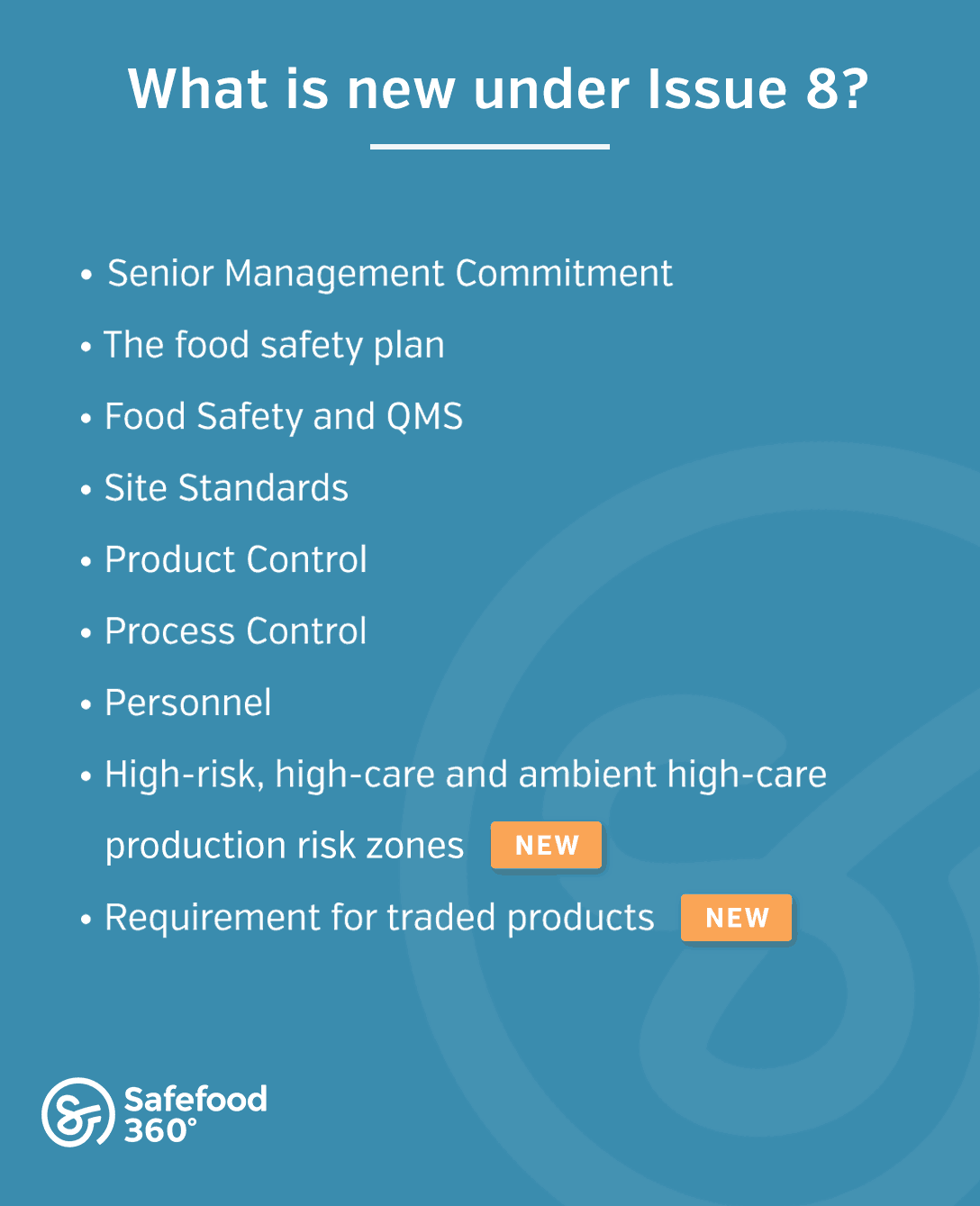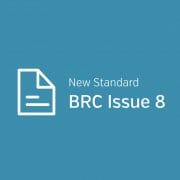BRC Auditing – What to expect under Food Issue 8
Since its initial publication in 1998, the British Retail Consortium Global Standards (BRCGS) has arguably become the most widely used of the commercial standards for assuring the production of safe food, with more than 25,000 certified sites issued by more than 1,700 auditors under 18 different food safety categories.
Initially formed to help the UK food industry meet legislative requirements of the European Union General Product Safety Directive and the UK Food Safety Act, the BRCGS has since made significant progress in harmonizing food safety standards across the supply chain overall.
As a GFSI certification scheme, part of this progress can be attributed to the requirement to regularly revise and update program specifications and publish a fresh code on a frequent basis.
The latest in this series of revisions, the eagerly anticipated Issue 8, was released in August, 2018, and first audits were conducted from 1st February 2019.
For food companies, the biggest challenge when a standard is updated is recognizing, understanding, and becoming familiar with the latest changes and what steps need to be taken to ensure you remain in alignment.
What is new under Food Issue 8
Issue 8 has seen a change moving from 7 sections to 9, with Production Risk Zones and Traded Goods joining the already defined Senior Management Commitment, HACCP, Food Safety, and QMS, Site Standards, Product Control, Process Control, and Personnel.
Collectively, there has been a pronounced focus on improving the food safety culture within the organization, which is most reflected in changes to environmental monitoring, supplier approval and monitoring, and new requirements for food defense.
With so many amendments since the previous version, it is important to give enough time to prepare fully for your next recertification audit, or indeed, your first certification attempt.
Individuals and sites may also consider BRC Conversion Training to familiarize themselves with these fresh demands. However, if time and resources are constrained, what follows below is a brief step-by-step process of what you might expect during an on-site BRC audit.

Opening Meeting
What have first audits and dates in common?
They could be both stressful and uncomfortable, however, how you set the tone at the start can affect whether you have a pleasant time or are in for a night (or several days as in the case of an audit) of discomfort.
Audits are an impartial examination of the documents, processes and procedures and systems of your business complies with the standard you are implementing, and even best practices, laws and policies.
Essentially, a successful BRC audit will demonstrate commitment to the BRC standard and show that you are doing what you say you are while also giving confidence to your customers that you are a supplier that can be trusted.
A BRCGS audit will begin with an opening session of adequate length which will:
- Confirm the scope of the audit
- Confirm the audit agenda including manufacturing schedule, break and meal agreements
- Explain the audit assessment method
- Explain staff roles (both on-site staff and those attending the audit (e.g., Auditor(s) and any witness evaluators)
The Opening Meeting is where the auditor and your team discuss the agenda and process of the audit along with introducing the key staff members who will be involved in the audit.
Site Auditing
Production processes constitute a substantial percentage of the audit.
Typically, within a manufacturing field, 50 percent of the audit will concentrate on Good Manufacturing Practices, and auditors will record the time spent on incorporation in the audit report.
These focus on productions include manufacturing, storage, dispatch, engineering, laboratory equipment on-site, and external regions such as site safety.
The audit should not focus on reading through various papers or records in an office, but on auditing processes in the manufacturing fields.
For example, receiving goods could be audited by reading a copy of the policy, but it is preferable to ask a staff member in the area about the process and how the activities are completed and look for additional evidence during the audit (e.g., physically in the receiving and storage areas).
This means that during the site audit the auditor will do a walk around the whole facility including the outside of the premises.
They will be looking for you to showcase your compliance, though they may raise any discrepancies between your documentation and actions as a non-conformance, it is important to understand that from the auditor’s perspective they want you to pass if you are demonstrating commitment to the system and have adequately prepared.
At this stage, it’s good practice to have a process owner or senior manager available to escort the auditor and make them comfortable.
The audit is a co-operative process, so having a high domain expert involved will allow you to provide support to the auditor and assist their perception of how you handle things.
If you have gotten to this stage and are still unsure of how you can prepare, we covered this topic before in our previous blog, 6 actionable steps to passing your first audit.
Document Review
The review of procedures, policies and records is completed relevant to the section of the standard being assessed.
While the document review and site audit go hand in hand, it’s important to consider that although the document review can happen as part of the desk audit, equally, it can take place in real-time on the production floor as auditors review documentation being completed as production is happening.
For example, HACCP process flow diagrams should match the real activity observed, as the CCPs and critical limits mentioned in the HACCP documentation are compared with manufacturing documents and processes, and identifying glass or difficult plastic products can be checked in the register of glass.
Moreover, the auditor will then know which training items should have been completed and the records are relevant to the members of the active staff.
Getting ahead of the audit in advance and making sure all registers and specifications are completed and available to check on the day is always good practice.
Although this may seem daunting and considerable work, the more you understand and know the products and capabilities in your business, the better prepared you will be for liaising with the auditor on the day.
Product Changeovers
You can expect that the Auditors will want to watch a product changeover happening on a running production line.
They will want to check the clean down procedure between the changeover and if staff are conducting this according to the procedure.
Witnessing this is performed effectively should demonstrate that employees have been trained correctly to carry out the changeover to eliminate potential allergens or speciation contamination between runs, providing a guarantee of sorts to the level of quality control.
They will also be keeping an eye to make sure staff (when applicable) are changing PPE during the changeover.
If any member of staff does not follow the procedure, they may observe QA/Team Leader who is supervising the changeover to check if they will notice this and fix any issue or anything that has not been done correctly.
If the auditor finds that the procedure has not been followed correctly, they may raise a Non-Conformance.
The audit plan shall include at least one item change and it is good practice to address this at the opening meeting to determine when the changes will occur.
Interviewing Senior Managers & Staff
This step can follow on from the site audit and document review.
During this period the auditor can also ask staff questions on their role, talk to them about their day to day activities and may also ask them to demonstrate an activity, e.g., carry out a metal detection check according to the way they have been trained, in order to determine if it will match what the procedure says.
When this is requested the auditor will observe the skills of the staff in order to understand the effectiveness of internal training.
An important takeaway for any audit is to remember that is not the auditor’s responsibility to ask the right questions to reveal whether a business complies or not, but rather it is the organization’s duty to prove to the auditor that it is adherent to the standard.
Interviewing the team members provides an understanding into the culture of the business and effectively navigating this step will reinforce the existence of well-informed, well-trained employees who are aware of what the standard requires of them and a commitment to its implementation and overall product safety.
Line Start Up
Similar to the product change over, an auditor may want to witness the start up phase of a production line or area.
They may want to observe activities done before start-up and check this out against the procedure to make sure it is being followed.
This will provide the auditor an opportunity to review line start up inspection, acceptance criteria and reflect the employee’s understanding of the control points and requirements.
Equipment Hygiene
The auditor will review hygiene Standard Operating Procedures and inspect some pieces of equipment. The auditor may want to witness the wash area to see what way equipment is being cleaned throughout the production run and he/she may also want to witness any equipment has been previously cleaned and inspect this.
In some cases, they may ask for equipment to be dismantled so they have a more detailed inspection.
They may want to review where the hygiene checks have been recorded and may then also then ask for swab results or ATP results of a particular piece of equipment.
At this stage, there is no substitute for hard work.
Take your time and perform your processes to the same rigors and extent that you typically would and be vigilant in its application.
Traceability and Vertical Audit
The auditor will pick a product produced on a certain day and a traceability assessment will need to be conducted, so be prepared to perform this in advance.
This means demonstrating a full understanding of the amount of units produced and their onward journey in the supply chain following production, i.e., where were they shipped too, then break it down and trace each raw material as per the batch number back to the supplier.
You also need to gather the specs for each ingredient and all production records used, essentially meaning an inclusive mastering of all processes from Intake to Dispatch.
If you are utilizing a system like Safefood 360° which brings all your food safety management systems programs and procedures together into one unified version of the truth, this is a much easier take to accomplish than if you were conducting this with a traditional paper-based, or shared drive system, or having multiple fragmented systems that do not talk to each other.
If you are beholden to the more cumbersome approaches, ensuring you are ready for this stage can arguably be the biggest requirement of any audit.
Failing to have your documentation at the ready for the auditor may be a sign that you are not committed to the system and do not have mastery over it.
Complying to the above will take time, resources, and come at a financial cost to the company to ensure you are ready, but ultimately preparing your documentation and ensuring it is in alignment at this stage should always best the cost of a re-certification and having the auditor back to review.
Mass Balance
A quantity check or mass balance can also be defined as reconciliation.
The mass balance is the quantity of incoming raw material against the quantity used in the resulting finished products, taking process waste and rework into account.
The Standard states that to account for the materials used, a volume check or mass balance should be performed in any traceability test.
Usually an auditor will select an ingredient from the traceability exercise and ask for the batch of that ingredient to be traced back to supplier and also where has that batch number been used in production, e.g., you might have a batch of Eggs and you need to trace that batch to all finished products it has been used in and account for it all, even if there is some of that batch left you need to basically state it has not been used and is in “Fridge store 1”, etc.
The BRC itself claims that the mass balance check will likely not be able to account for all materials to a 100% accuracy, however, “the company needs to be able to justify any discrepancies that it understands the nature of the variance (e.g., through dehydration of fresh ingredients, typical wastage, on equipment or portion variances).
One final point to note is that if you are familiar with Issue 7, another change that has been made is the removal of the word ‘full’ from the traceability recovery.
You are required to perform this across the range of products each year, and in instances where the products manufactured in the site are the same or similar, a minimum of one test should be completed each year.
Lastly, if a site makes a specific product claim, traceability tests should be performed at a regular frequency that meets specific relevant scheme requirements.
Label Review
Incorrect labels being used can be a significant cause of product withdrawal and recall in several areas of the globe.
At this penultimate stage, the auditor will select a product (more than likely the one chosen for the traceability exercise) and they will then compare the label to the specification to make sure everything is compliant to the legislation (FIR), e.g., nutritional and ingredient information, as well as the allergen declaration.
At this stage, if you have demonstrated a mastery of all other elements of the audit, this should hopefully be a relatively straightforward request and hopefully not provide too much in the way of hurdles.
Closing Meeting
Finally, the team that participated in the opening session will be invited back to the closing session to complete the audit.
The auditor will briefly address their results, including favorable remarks, but also any Non-Conformance’s that have been identified.
In most cases, the results / grades will be provided, however, the Corrective Actions for the NC’s will have to be submitted and the overall report submitted to BRC before the official certificate with the grade is provided.
Hopefully, provided that all has gone well and following proper understanding of what is required at each stage and adequate preparation, this will lead to a positive affirmation that your business has met the requirements of the standard and you can confidentially put your best foot forward.
A final caveat to always consider however is that even when successful, a good audit dose not mean that you are infallible and your system will require continuous vigilance and improvement to ensure you are always offering the optimum quality and assurance to your customers.
Understand this and it should make all other audits going forward a more pleasant, and less daunting prospect.










Leave a Reply
Want to join the discussion?Feel free to contribute!